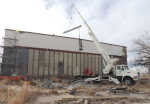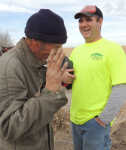Abandoned World War II base was once thriving facility

McCOOK, Nebraska -- The bombing of Pearl Harbor thrust the United States into World War II. It also gave McCook a bustling military complex that is only a shadow of its former self today.
Surrounded by cornfields and grazing cows, there's not much left of what was once 110 buildings of the Army Air Force training base north of McCook. But that hasn't stopped Dale Cotton of the McCook Army Air Base Historical Society from trying to preserve what is there.
"We, this nation as a whole, has lost its pioneer spirit," Cotton said, referring to the get-it-done attitude. "We are too quick to tear buildings down. We used to use what we have, fix it up, instead of buying something new."

Cotton has been a tireless advocate for the air base and was recently assisted in his efforts by Mark Cappel of McCook. Cappel donated his time and equipment to hoist 100 sheets of metal to the roof of one of five original hangars still standing.
Cappel said he grew up a few miles from the area and always has been captivated by the ghostly, vacant hangars rising up from the horizon. "I don't want to see it torn down, I'd like to preserve it," he said.
During 1943-1945, the base included three runways, barracks for 5,000 men and employed 500 civilians.

It was one of 11 Army Air Force training bases in Nebraska during World War II and the last stop for heavy bomber crews that would fly the B-17 Flying Fortress, B-24 Liberator and B-29 Super Fortress.
Ultimately, 15,000 service men were stationed on the 2,100-acre base, which became a mini-community of its own, with its own hospital, officer's club, chapel, theater, band, fire station, post office, photo lab, library and a military police unit.
The hangar that Cappel and Cotton placed the metal sheets was originally built as a satellite bomb squadron hangar, for the air base in Kearney, Nebraska. It was used for B-17s and B-24s but was not large enough for the B-29s, Cotton said. Another, larger hangar was built later at the McCook base for "100-hour inspections" of B-29s, Cotton said, where the planes were examined meticulously to make sure everything was in proper order before taking off for Europe.
Cotton said the metal sheeting is one step in preserving this particular hangar and hopes to have a "living museum" in place sometime in the future, that would include mock-ups of the bomber planes used there.
Cotton cited Schamel's Salvage and Don Roberts, both of McCook, for helping with this project.
